Sourdough Bread Starter Guide
Last year I dedicated myself to learning the art of sourdough and now I bake bread almost weekly! It has a bit of a learning curve and when I got started I was overwhelmed with the amount of information. I didn’t know where to start! My goal with this blog post is to provide you with step-by-step instructions and resources to get you started with baking sourdough bread as quickly as possible.
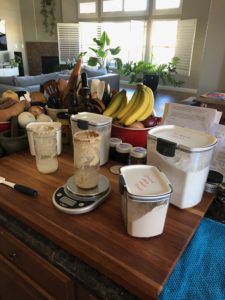
Step 1: Starter
The first thing you’ll need is a sourdough starter. This is a living, breathing organism that gives your bread rise, flavor, and the signature sourdough holes you’re looking for. You can acquire starter a few ways – create your own, buy one, or you can kindly ask your local sourdough bakery for some.
Create Your Own
Creating your own takes a few days, but it’s worth it if you enjoy learning the process and have the time. I recommend The Perfect Loaf’s Sourdough Starter. He has a fantastic blog with many helpful tips and I love the way he lays out his recipes with beautiful visuals. Be sure to follow his Instagram too, his baking is very inspiring!
Buy Online
Buying a starter online assures that it’s active enough to bake with, which can save you lots of time. I recommend the King Arthur Sourdough Starter. Since it’s a live starter, you feed it once with flour and water then you’re set to bake!
Ask a Sourdough Friend or Local Bakery
And lastly, you can ask or barter for some from your local bakery or baker friends. Most people love to help and are proud of their starters. People go through great lengths to keep their starters happy and bubbling with activity. Many are fed daily and are several years old! This method gets you the most active starter the quickest. Plus it connects you with the source, which can be a valuable sourdough resource.
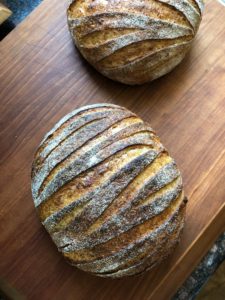
Step 2: Baking
Bread Basics
Once you have an active starter, you can start baking! Start with a simple recipe to help you nail down the basics of bread making. I started with King Arthur’s Rustic Sourdough Bread. This recipe is great because it uses sourdough starter with commercial yeast. This helps foolproof the rise and allows you to focus on learning the steps necessary to make bread. I made this recipe a few times and once I felt confident, I transitioned to using just my starter.
Traditional Sourdough
A traditional sourdough recipe uses purely sourdough starter to create rise and flavor. King Arthur’s Extra-Tangy Sourdough Bread recipe is a great start to the sourdough world. It teaches you how to knead, the activity to watch for, how to retard in the fridge, and gives you an understanding of the sourdough baking process. Once you bake this loaf with success, congratulate yourself! You made sourdough bread! Pretty amazing that flour, water, salt and starter can turn into such light and fluffy bread.
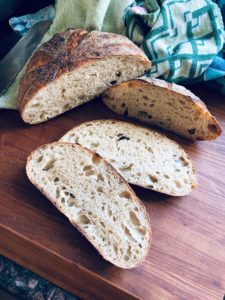
Step 3: Test and Refine
Once you’ve nailed down the basics, it’s time to refine your techniques. Most recipes have commonalities, but advanced bread makers will add a few steps that make a huge difference. Some of these techniques include using a fresh fed starter, adding an autolyse period, increasing the hydration, utilizing the slap and fold method, mixing flours, and creative scoring. All these factors affect sourdough results.
Well Fed Starter
Use a portion of your starter to make a recipe specific leaven. Leaven or levain is a portion of your mother starter mixed with fresh flours and water used at peak activity to create optimal bread rise.
Autolyse
An autolyse period requires you to mix flour and water together thirty minutes to a couple hours before adding the leaven or salt. This step increases the workability of the dough and makes for a more open crumb.
Increased Hydration
Increasing the water content in your dough results in bigger sourdough holes and even affects the crust, making it thinner and crispier.
Slap and Fold Method
This method of kneading is great for high hydration dough. When you push the limits of hydration it makes the dough very sticky and hard to work with. This technique makes it easier to mix, aerate, and develop the wet dough. This leads to cohesive structure and open sourdough holes.
Mixing Flours
Sourdough bread can be made with a variety of flours and the flavor combinations are endless. You can even fresh mill your grain and level up your loaf!
Creative Scoring
Scoring your bread directs air escape while baking and it’s your signature. A way to add character and have fun with designs. I love Wire Monkey Shop’s bread lames 🙂
Step 4: Test New Recipes 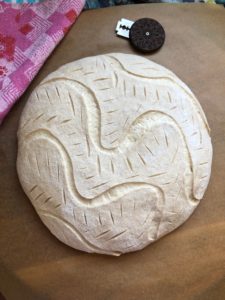
Once you’re baking sourdough bread with consistency and feel confidant in your abilities, it’s time to test new recipes! You can take your loaves a few directions and the options really are endless. You can add herbs, fruit, vegetable purees, olives, cheese, nuts, and a variety of seeds. Savory or sweet, both are delicious.
Herbs
Adding fresh or dried herbs can really boost the flavor of your bread, without having to modify a classic recipe. Herbs don’t affect the hydration or fat content of your dough, so they won’t change the structure of your loaf. This makes them a great flavor addition to start with.
Fruit
Dried fruit is a classic way to sweeten your loaf. You add them after you’ve mixed the dough. Depending on the dried fruit you’re using, you may need to soak them overnight to soften before use. Smaller fruit like cranberries, raisins, and dates are fine to use fine without soaking.
Vegetables
Fresh garden produce provides an array of flavor profiles. You can shred, chop, or mince vegetables to add. Or puree them for a seamless texture. You can achieve vibrant bread colors with pureed purple potatoes, carrots, beets, and more!
Olives
Green, black, kalamata, a mix… all olives make for a savory addition. Tender and full of flavor, they add depth to your sourdough bread. They also mix well with herbs, garlic cloves, and cheese.
Cheese
Fold in shredded cheese, cubes, or a mix. Shredded cheese flavors through while the cubes leave pockets of gooey goodness. And a mix sounds best of all!
Nuts and Seeds
Some nuts, seeds, and grains are too hard to just mix into your dough. You will need to soak them for a few hours before adding them. Not only does this soften them, it also keeps the nuts, seeds, and grains from soaking up the liquid in your dough. This keeps your dough measurements accurate and doesn’t lead to a dry loaf.
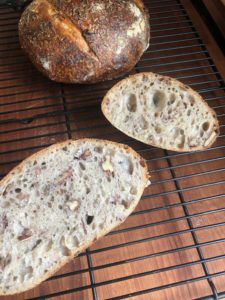
Step 5: Starter Upkeep and Discard
Sourdough starter needs regular attention to stay alive and healthy. You can feed it daily or weekly, this all depends on how much you bake. I don’t bake often, so I feed mine once or twice a week with a 1:1:1, starter to flour to water ratio. I also keep it in the fridge, which slows the fermentation process. I keep it simple and feed 100 grams of starter with 100 grams of flour and 100 grams of water. This keeps my starter at 100% hydration which is what most recipes call for. Every time you feed your starter, you will throw some away. This is known as sourdough discard and even though it’s not active enough for breads, it can still be used for a variety of recipes.
Fresh Fed Sourdough Starter
Use fresh fed starter for sourdough bread to create optimal rise.
Sourdough Discard
Use sourdough discard for pancakes, pizza, english muffins, pretzels, crackers, cakes, and more. The options are endless.
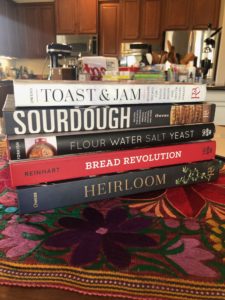
Book and Website Recommendations
Once you dive into sourdough bread, a whole new world of talented bakers starts to appear. I’m constantly inspired and wowed by their techniques and creations, it keeps me practicing. Below, I’ve listed a few of my go-to books, website resources, and favorite recipes.
Books
Bread Revolution by Peter Reinhart
Flour, Water, Salt, Yeast by Ken Forkish
Websites
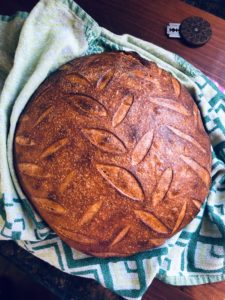
Recipes
My favorite and most baked loaf is the Brooklyn Sourdough recipe from Sarah Owen’s book: Sourdough
Sarah Owen’s: Seeded Sandwich Bread
Joshua Weissman’s: No Knead Beginner Sourdough Bread
Joshua Weissman’s: The Ultimate Homemade Sourdough Bread
The Perfect Loaf’s: Beginner’s Sourdough Bread
The Perfect Loaf’s: Banana Bread
King Arthur’s: Sourdough Pumpkin Spice Bread
King Arthur’s: Cinnamon Raisin Sourdough Bread
2 Comments
Leave a Reply

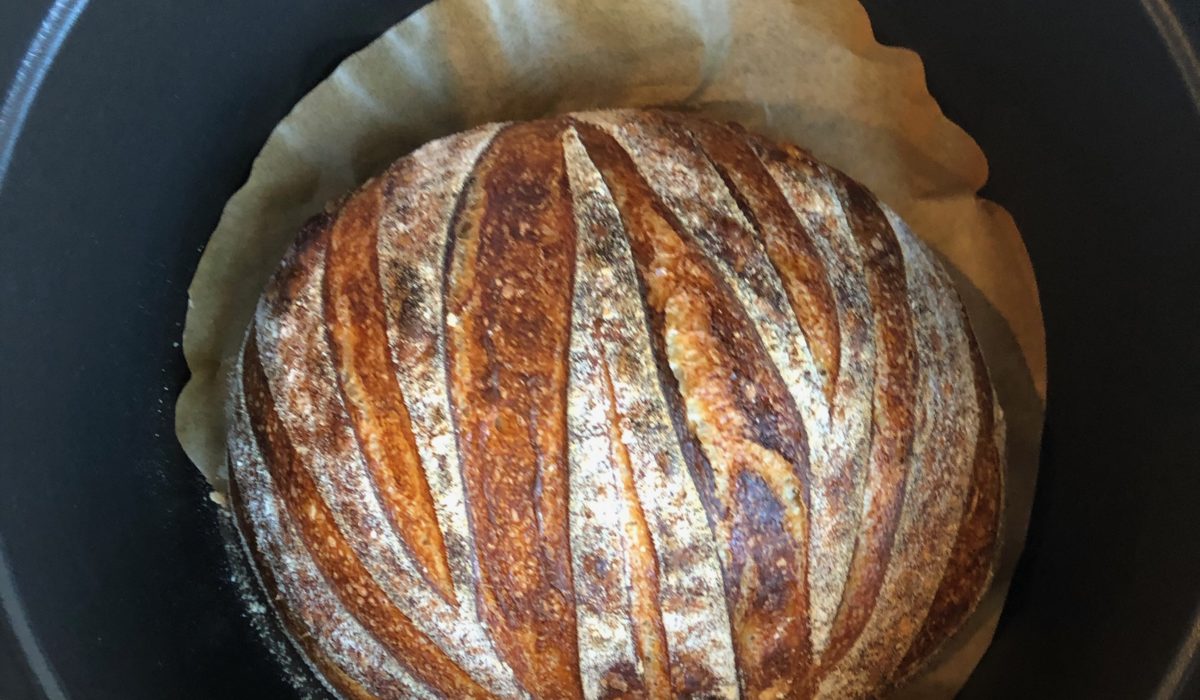



This is an awesome resource! Thank you for narrowing it down to just the basics. What a great time to try sourdough baking!
Thank you!! Agree, perfect time 🙂